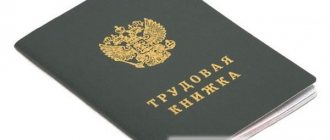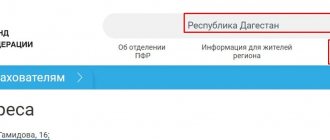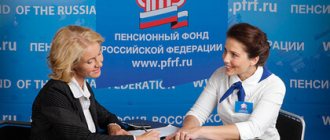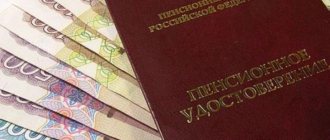The pension system in the republic consists of 3 parts:
- Provision from the state , consisting of a 20% tax from the working population and 13% from the state for medical care.
- Mandatory fund. 2% of a citizen’s personal income and 4% from the state are transferred to it. Such a contribution can be voluntary for Estonians born before 1983. For everyone else, this contribution is compulsory and begins to be debited from the first salary after reaching adulthood.
- Additional pension fund . The citizen determines it independently. It is possible to change the amount of the contribution, the frequency of payments, terminate the contract early or obtain a payment holiday. Such payments are provided to a person starting from 55 years of age. This pension is tax refundable when contributions do not exceed 6,000 euros or 15% of income before deducting expenses. In cases where the contract with the insurer is open-ended, and the funds were there for more than 5 years, then such a pension is not taxed at all.
When concluding an agreement with a specified period or in case of withdrawing the entire amount, the tax is 10%.
The pension currently consists of the basic part, length of service and insurance for those who retired since 1999.
Types of pensions in Estonia
The Republic provides its citizens with the following types of pensions:
- State.
- by age (experience required);
- for disability, regardless of length of service;
- for loss of source of income (intended for disabled Estonian citizens);
- early retirement (when working in a production facility that does not allow working until retirement age);
- support pension (made 5 years after the age) in the absence of another type of accrual.
- Professional. The employer makes the payments. Such contributions can be either optional or forced.
- Voluntary. Contributions are made at the discretion of the future recipient of payments.
Types of government benefits
If we consider the state part of the pension in more detail, it should be noted that there are several payment options that an Estonian citizen has the right to count on, subject to the occurrence of certain circumstances. Pensions paid by the state can be of the following types:
- For old age, subject to a mandatory work experience of 15 years.
- Due to disability. The amount of payments does not depend on length of service.
- Due to loss of source of income. Most often assigned to disabled citizens.
- Early retirement.
- Pension support.
The latter deserves special attention, since it is a serious help for low-income pensioners. It assumes that a citizen will be able to receive additional benefits provided that he does not receive another pension, with the exception of the “national” pension. They are accrued 5 years after the appointment of the “national” pension.
Watch a video about state benefits in Estonia.
Return to contents
Retirement age
The retirement age for men in Estonia in 2020 reaches 63 years.
For the female half of the population, determining this age is more complicated. It depends on the date of birth .
- Those born in 1951 have the right to retire starting from the age of 62, from 1951 to 1953 - from 62.5 years, in 1953 - from 63 years.
In 2020 The Estonian authorities decided that the female half of the population, born from 1954 to 1960, have the right to retire from 63 years or more.
The retirement age limit will gradually increase.
Pension system in Estonia
The pension system of the state in question provides for the following elements:
- First level. This value is designated as the minimum subsistence level. Pensions paid by the state depend on how much tax payment goes into the pension system. The number of working-age population is subject to reduction.
- The second stage, which consists of transfers made by citizens. Every month they are responsible for transferring two percent, while 4% is added to this amount, which is transferred by government bodies. As a result, the transfer amounts to 6%, which a person receives upon retirement. Accordingly, the more earnings, the greater the deductions. The use of this system is mandatory for citizens who were born after 1982. When a person who has reached the age of majority does not have the opportunity to independently decide where to transfer funds for savings, a drawing of lots is used to make a choice.
- The third stage gives a person the opportunity, based on his decision, to draw a conclusion about what the amount of transfers will be. For a normal standard of living, payments should be equal to about 65 percent of income. At the same time, the first forty percent are transferred to the first two levels.
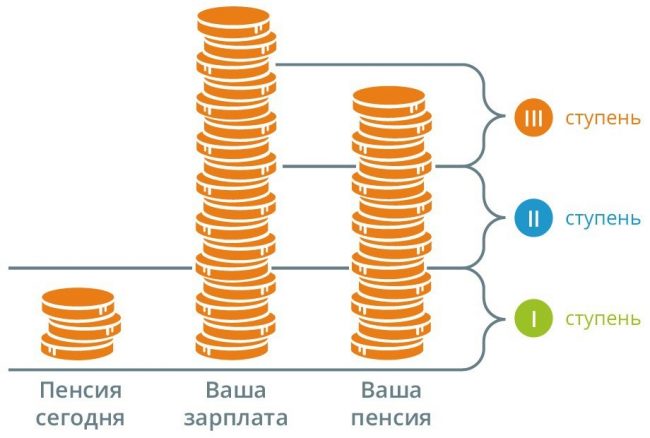
Important! The total amount will be calculated as a base value of 160 euros, bonuses received before 1999 and amounts received according to the period of insurance. The calculation has individual meaning.
Types of old age benefits
If we look at state benefits from a more detailed point of view, we need to point out that there are several variations of payments. A citizen will be able to use them if he meets certain conditions.
There are several types of payments:
- benefits related to old age, these amounts are intended for persons who have 15 years of experience;
- for loss of ability to work. In this case, the amount of payments is not related to production;
- associated with loss of income. This type is prescribed to persons who have lost their ability to work;
- early type pensions;
- support payments.
The last type should be considered in detail, because it is a serious step towards supporting a pensioner who receives a small level of income. The main condition is that the person should not receive another type of pension.
It is also useful to read: Table of pension amounts in countries of the world
Features of the third pillar of pension
Voluntary savings insurance is considered as a service that is provided by many private funds and insurance companies. There are several features to consider. A distinctive feature is that the conditions are flexible, which makes it possible to make the system extremely comfortable for the citizen.
This type of insurance makes it possible to increase the amount of your future pension. A citizen has the right to regulate the amount and periods that are used to deposit funds. He can also terminate the agreement earlier than the established time and use a payment holiday.
The state authorities of the state in question have established that a citizen can take advantage of these payments upon reaching 55 years of age. In addition, the user of this program is provided with tax benefits. Initially, they indicate compensation for income tax, provided that the citizen receives an income of less than six thousand euros per year.
The minimum period for funds to remain in the company is 5 years.
Attention! It is also possible to be exempt from paying this type of tax if an open-ended agreement is signed.
What is early and deferred retirement?
The state pension system provides the opportunity to receive early or deferred pension payments. In the first case, it is understood that a person has the right to receive pension status three years before reaching age. A mandatory requirement is that he submits to the authorized body documentation confirming the existence of an output of 15 years.
It is important to point out that premature registration of pension status is associated with a reduction in future pension. Every month a citizen is paid 0.4%. In a situation where a person decides to receive payments three years earlier, he loses approximately 14.4% of the total payments.
It must be pointed out that after the early payment is processed, the citizen will receive a receipt, but it will not be possible from him in the future. There is also the possibility of making a deferred payment. They are intended to increase the amount of future pensions. The surcharge is 0.9%, and the period of retirement for a well-deserved rest is not limited. This suggests that over the other 3 years, a person can increase their benefits by 27%.
It is also useful to read: What is the pension in the countries of the former USSR
Pension amount
The pension is formed from:
- The basic part is 162 euros.
- Experience share , calculated for work until the end of 1998.
- Insurance share . The amount of this payment is affected by length of service, presence of maternity leave, military service, time of full-time education above average and temporary disability. This payment is calculated for each citizen individually. In addition to these factors, the payment depends on how much tax the citizen has paid since the beginning of 1999.
Important! Each year of service is reflected in a pension of 5.77 euros.
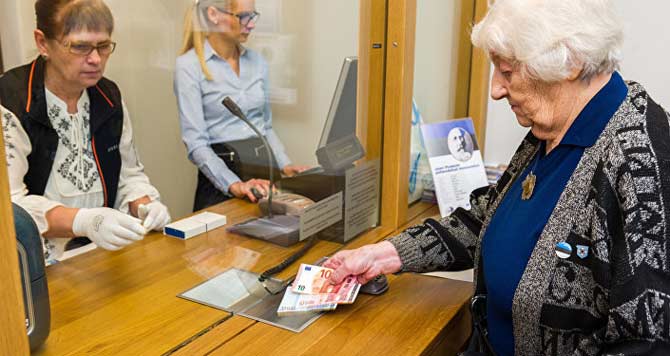
Every year in the spring, the country's government recalculates pensions. The amount of the pension payment is multiplied by an index, 1/5 of which depends on the annual rise in prices, and the rest on the growth in the social tax share. After such recalculation, the pension is paid starting from April 1.
Average pension
The average pension payment in the republic is 391 euros (24,027 rubles). The amount of the final payment is affected by length of service, pre-retirement income or participation in programs.
If the accumulated experience is 15 years, then a resident of Estonia receives 223 euros, 30 years - 301 euros, 40 years - 354 euros, over 44 years - 375 euros.
In 2020, the Estonian authorities plans to raise pensions by 5.7%.
Minimum pension
If a person has no work experience, then he is entitled to a national pension . Currently, the minimum pension for an Estonian citizen is 158.37 euros.
Special pension for professional conditions

Also, for representatives of certain professions and specialists working in hazardous conditions, special conditions for retirement are provided.
These include:
- police officers;
- prosecutors;
- Defense Forces personnel;
- judges;
- state control officials;
- justice camps;
- miners and underground workers;
- metallurgists;
- oil workers;
- electrical engineering;
- manufacturers of building materials;
- workers associated with the production of glass, pulp, paper, rail and sea transport;
- workers associated with radioactive substances, ionizing radiation, rare earth metals;
- divers;
- mining workers;
- non-ferrous metallurgists;
- chemical industry workers;
- power plant and metalworking workers.
Thus, police officers have the right to retire 10 years earlier, provided that the police officer’s age at the time of retirement is at least 55 years old, and the official length of service is at least 20 years. In this case, the police officer can expect to receive a pension in the amount of 50% of his salary.
Prosecutors retire like all citizens, at 63 years old. But they are entitled to 50% of their salary for partial disability and 65% for total disability. To do this, you need to work as a prosecutor for at least 15 years.
Military personnel of the country's defense have the right to receive 50% of the average salary in the country for their position if:
- Their age is at least 50 years.
- Actual work experience of at least 20 years.
If killed in the line of duty, members of the serviceman's family may receive a pension. It is 1.5 times the average salary of a military personnel.
State control employees are entitled to receive an old-age pension in the amount of 50% of the current salary if they have five years of experience, and 70% if they have ten years of experience. At the same time, law enforcement officers can receive up to 70% of the current salary, with at least five years of service in the position.
Those workers who worked in conditions harmful to health have the right to early retirement for 10 years. But they must have at least 20-25 years of work experience, 10-13 of which were worked directly in hazardous working conditions.
Pension schemes
Payments in Estonia are calculated according to several schemes:
- Pension upon retirement
The payment is made from available funds in the account or from the capital of “today’s” taxpayers. The scheme is not very relevant, since the population is decreasing and creating a negative increase.
- Pension with specified contribution
It implies the assignment of an exact amount of regular contribution to the pension fund (percentage of income), which is not guaranteed and depends on the duration of the scheme.
- Scheme with assigned payment amount
Based on a specified retirement benefit amount. Contributions depend directly on the desired result, length of service and salary during the pre-retirement period.
- Payments
Depends on the amount of savings at the time of reaching retirement age.
Pensions in Estonia for Russians
This year, the pension for Russians living in Estonia is 312 euros .
Many citizens seek to go to other European countries to earn money. The outflow of young people is so large that pensioners make up almost half of the population of Estonia.
Because of this state of affairs, the retirement age for Russian citizens can be raised to 74 years, and the length of service to receive a pension can reach 44 years. Only in this case the payment amount can increase to 396 euros.
When calculating the pension, the day of the month when the application for receiving it is submitted is taken into account. The initial payment includes the amount of unpaid funds from the date of application. Thus, a person receives a payment in the amount of a pension for several months.
Transfer of pension from Estonia to Russia
Estonia and Russia have concluded an agreement on mutual support for pensioners. In both countries, the amount of this payment directly depends on the length of service obtained in the territory of each state separately.
If in retirement a person moves from Russia to Estonia or vice versa, then the cash payment to him is made by the country that accumulated the funds.
Estonian citizens who find themselves in Russia are deprived of the national part of the pension, but receive the right to benefits from Russia.
The disadvantages of such a move include:
- lack of a pension for the loss of a working family member;
- When funds are credited to a bank account, euros are converted to rubles. Due to the difference in the exchange rate and the bank's interest rate, a certain amount of money is lost for servicing.
The pension is paid in a specialized institution on the 20th day of every second month of the quarter. The currency exchange rate corresponds to the Central Bank.
Absolutely all pensions paid to citizens abroad are subject to income tax; there are no exceptions.

Pension for Russians living in Estonia
How, in the event of a change of country of residence - citizens moving from Russia to Estonia - are pensions assigned and paid?
This material discusses the order:
- applying for pensions and
- pension payments
when citizens move from Russia to Estonia.
Regulatory framework for the assignment, registration and payment of pensions when citizens move from Russia to Estonia
Pension provision for persons living (moving) on the territory of the Russian Federation and the Republic of Estonia and being their citizens or stateless persons is regulated by:
- Agreement between the Russian Federation and the Republic of Estonia on cooperation in the field of pensions of July 14, 2011 and
- Agreement dated October 6, 2011 between the Ministry of Health and Social Development of the Russian Federation and the Ministry of Social Affairs of the Republic of Estonia on the application of the above agreement.
The Treaty and Agreement came into force on April 1, 2012.
For Russia, the subject of the agreement is the purpose of:
- old age insurance pension (including early),
- disability insurance pension,
- insurance pension in case of loss of a breadwinner, as well as
- social pension.
Social pensions are assigned and paid in accordance with the legislation of the state in whose territory the citizen lives.
If a Russian pensioner was assigned a social pension when he lived in Russia, then when he moves to permanent residence in Estonia, the payment of the social pension stops, since the transfer of this type of pension outside the Russian Federation is not carried out.
How to receive a pension while living in Estonia in accordance with the agreement between Russia and Estonia on pension provision
Step 1. Determine whether you are included in the circle of persons covered by the pension agreement between Russia and Estonia.
This pension agreement applies to those who simultaneously meet two conditions:
- is a citizen of the Russian Federation or Estonia or a stateless person who is or was previously covered by the pension legislation of each country;
- permanently or temporarily resides legally on the territory of Russia or resides on the territory of Estonia as a permanent resident, or on the basis of a temporary residence permit or right of residence.
Step 2. Determine whether you have the right to receive a pension under Russian law
The right to an old-age insurance pension under Russian pension legislation arises under the following conditions:
- reaching the generally established retirement age (60 years for men, 55 years for women) or the age required for early retirement;
- availability of the required insurance experience: in 2020 - 8 years, followed by an annual increase to 15 years in 2024;
- Availability of the required amount of pension points: in 2020 – 11.4 points, followed by an annual increase to 30 in 2025.
The assignment of a pension to a Russian citizen living in Estonia is carried out according to the principle of proportionality:
- for pension experience acquired in the territories of Estonia (ESSR) and Russia (RSFSR), the pension is established by law and at the expense of the party in whose territory it was acquired.
Periods of pension experience acquired in the territory of the former USSR, except for the territories of the former RSFSR and the ESSR, are not taken into account when assigning a pension.
EXAMPLE: Assignment of a pension for length of service in Russia and Estonia
| Citizen of Russia or Estonia lives in Estonia | Russian experience – 9 years | For this period of work, Russia grants a pension | Total amount of assigned pension |
| Estonian experience – 10 years | For this period of work, Estonia grants a pension |
If a citizen does not have the required length of Russian experience, then when determining the right to an old-age insurance pension, the experience acquired both in the territory of Russia or the RSFSR, and in the territory of Estonia or the ESSR is summed up.
EXAMPLE:
- citizen I. has Russian citizenship and lives in Estonia;
- Russian experience – 5 years;
- Estonian experience – 10 years.
To acquire the right to assign an insurance pension under Russian law in 2020, among other conditions, 8 years of experience are required, therefore the summation of experience is applied.
In some cases, experience is not cumulative:
- the length of service does not reach a year and does not give the right to a pension under national law;
- periods of experience in different countries coincide in the time of their acquisition.
In the absence of the right to receive a pension, using the stated rules for summing up the pension experience, to determine the right to a pension , the pension experience acquired in the territory of a third state with which Russia and Estonia have relevant valid agreements is taken into account.
Currently it is:
- Bulgaria, Hungary, Spain, Latvia, Lithuania, Romania, Slovakia and Ukraine.
Step 3. Apply for an insurance pension
An application for a pension is submitted to the appropriate authority in the country of residence and is considered simultaneously submitted to the competent authority of another country. Citizens residing in Estonia submit an application to the Social Insurance Department of the Republic of Estonia.
The application must be accompanied by documents necessary for granting a pension. In particular, the following must be presented:
- passport,
- resident card,
- documents confirming the existence of insurance (work) experience (work book, work certificates, etc.),
- certificate of earnings.
Additional documents required to assign a pension are determined individually in each specific case:
- Marriage certificate,
- birth certificates of children, etc.
An approximate list of documents is posted on the website of the Pension Fund of the Russian Federation in the section “Pension provision for persons living abroad”.
https://www.pfrf.ru/grazdanam/pensionres/pens_zagran/
Step 4. Start receiving an insurance pension
The transfer of amounts of assigned Russian pensions to Estonia is carried out quarterly in the second month of each quarter to the account of the social security authority, which ensures that the amounts of Russian pensions are credited to the bank accounts of pension recipients.
The costs associated with the delivery of pensions are borne by the Pension Fund of the Russian Federation.
The annual submission of a document confirming the fact that the citizen is alive is not required with this procedure for payment (transfer) of pension.
For reference: Multi-channel helpline of the customer service of the Department of the Pension Fund of the Russian Federation on issues of pension provision for persons living abroad +
If you have any questions about the violation of your rights, or you find yourself in a difficult life situation, then an online duty lawyer is ready to advise you on this issue for free.
ASSIGNMENT, REGISTRATION, PAYMENT AND DELIVERY OF PENSION
Prospects
In the future, the Estonian authorities plan to radically change the pension system of the republic. Payments will be such that pensioners no longer need anything. Pension income must be sufficient for normal living in the country.
Residents of the republic will be given the opportunity to independently choose the time of retirement, make partial payments, freeze them and resume them.
The retirement age will correspond to life expectancy, and may reach 70 years. The proposed changes will not affect current citizens of retirement age and accumulated shares.
Watch the video: Estonia is going to pay pensions to citizens living abroad.
Pensions in Estonia are formed from a number of important points, which become stricter every year, but affect the amount of payments. And if, after working in the republic for some time, a person decides to move to Russia, it is recommended to have impressive work experience in the territory of the pension fund.
Pension benefits for Estonians

Before answering the question “What is the average pension in Estonia in 2020?” First of all, it is necessary to clarify how pensions are calculated. The following items are used as payment components:
- a fixed part guaranteed by the state - its value is 162 euros, which in rubles is equivalent to 12 thousand;
- labor share, which depends on length of service until 1999, when the accrual conditions were adjusted;
- The insurance share is calculated on an individual basis, since the formula takes into account personal achievements or employment in specific life periods. When determining, the following indicators are used: total length of work experience, duration of maternity leave, service in the armed forces, duration of full-time study at a higher educational institution. Time periods when the pensioner was temporarily disabled are also taken into account;
- the amount of tax contributions paid by an Estonian citizen since 1999.
The formula uses a direct relationship: one year of work experience is equivalent to 5.77 euros, which encourages the population to work officially. Russia also provides for the influence of length of service, but due to the lack of transparency in calculations, many people simply do not understand how their pension provision is established, which somewhat reduces motivation.
We recommend these articles:
What is the retirement age in Finland?
What is the average pension in Latvia?
Annual increase – indexation
There is a planned indexation of pensions in Estonia. The factors determining the need for this procedure are based on a basis similar to the Russian economy - inflation, the intensity of which is reflected in the price tag for vital commodity items. Yet the process is somewhat different, since the increase occurs on a specific index, in which the price increase takes up only a fifth. The remaining share is determined by the dynamics of social tax.
The monthly pension in Estonia is set taking into account indexation at the beginning of April.
Average pension benefit for an Estonian citizen
The amount of old-age payments for the average Estonian is about 390 euros, which at the current exchange rate in rubles is 29 thousand. The final amount is largely determined by individual indicators, such as:
- the person's work experience;
- the amount of earnings during official work activities;
- the fact of participation in special social programs.
Experience has the most significant impact on the final amount of payments. So, depending on its duration, an Estonian can count on specific amounts:
| Length of experience (in years). | Amount of pension provision (in euros). |
| 15. | 223. |
| 30. | 301. |
| 40. | 354. |
| More than 44. | 375. |
Based on only one indicator - length of service - the pension of an Estonian citizen who has worked for at least 15 years is 16.5 thousand rubles, which implies a larger amount than for a Russian citizen under identical conditions. Such a division depends primarily on the state of the state budget and on how many pensioners there are in Estonia.
The minimum that an Estonian can count on

The minimum pension in Estonia in 2020 is assigned to those persons who, for some reason, were unable to achieve the minimum requirements regarding work experience. In this case, they are paid a so-called national pension, the amount of which is 158 euros, which translated into Russian rubles is 12 thousand.
When comparing the pension systems of Estonia and the Russian Federation, one can draw a conclusion about the transparency of the schemes used in the calculation for the first state. It is also worth noting that Estonian pensioners receive on average more than older people in the Russian Federation. However, in order to retire, Estonian women have to work three years longer than Russian women, while for the male population the opposite situation is relevant - a Russian citizen can count on state support for old age upon reaching 65 years of age, while an Estonian citizen can already count on 63 years of age.



